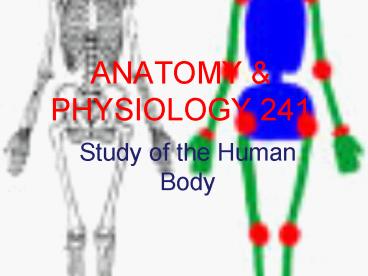ANATOMY - PowerPoint PPT Presentation
1 / 21
Title:
ANATOMY
Description:
ANATOMY & PHYSIOLOGY 241 Study of the Human Body ANATOMY & PHYSIOLOGY ANATOMY structure how form & structure relate to each other PHYSIOLOGY how anatomy functions ... – PowerPoint PPT presentation
Number of Views:217
Avg rating:3.0/5.0
Title: ANATOMY
1
ANATOMY PHYSIOLOGY 241
- Study of the Human Body
2
ANATOMY PHYSIOLOGY
- ANATOMY
- structure
- how form structure relate to each other
- PHYSIOLOGY
- how anatomy functions
- Structure determines Function
- complementarity of structure function
3
WAYS TO STUDY ANATOMY
- Microscopic
- Cytology
- Study of cells
- Histology
- Study of tissues
- Gross
- Surface
- Regional
- Systemic
- Developmental
4
Levels of Organization
5
LEVELS OF ORGANIZATION
- Chemical or Molecular
- Atoms?molecules
- Cellular
- basic unit of structure and function in living
things - makes up organelles
- Tissue Level
- cells of similar structure function working
together to perform a specific activity4 basic
types connective, epithelial, muscle and nerve
6
LEVELS OF ORGANIZATION
- Organ Level
- tissues working together to perform a specific
activity - Examples - heart, brain, skin, etc.
- Organ Systems Level groups of two or more
tissues working together to perform a specific
function11 organ systems - circulatory,
digestive, endocrine, urinary,
immune(lymphatic), integumentary, muscular,
nervous, reproductive, respiratory skeletal - Organism Levelentire living things that can
carry out all basic life processes-usually made
up of organ systems - An organism may be made of one cell
7
Basic Life Processes
- Organisms share 6 basic life processes
- 1. Metabolism
- 2. Responsiveness
- 3. Movement
- 4. Differentiation
- 5. Growth
- 6. Reproduction
8
Metabolism
- sum of all chemical processes that take place in
the body - Catabolism
- larger macromolecules are broken down into
smaller subunits or monomers - Anabolism
- larger macromolecules are formed from smaller
submits.
9
Responsiveness
- ability to detect respond to changes
10
Movement
11
Differentiation
- ability of cells to develop from an unspecialized
cell into a specialized cell
12
Growth
- a way to increase in size
13
Reproduction
- making a whole new organism
- Cells able to divide and make new cells for
- Growth
- replacement
14
Homeostasis
- organ systems are interdependent
- share same environment
- composition effects all inhabitants
- internal environment must be kept stable
- maintaining stable internal environments-homeostas
is - dynamic equilibrium
15
Homeostasis
- varies around a Set Point
- average value for a variable
- specific for each individual
- determined by genetics
- normal ranges for a species
- temperature 36.7 37.2
16
HOMEOSTATIC REGULATION
- Autoregulation
- cells, tissues, organs adjust automatically to
environmental changes - Extrinsic Regulation
- Nervous System
- Fast
- Short lasting
- Crisis management
- Endocrine System
- Longer to react
- Longer lasting
17
Parts of Homeostatic Regulation
- Receptor
- sensitive to environmental change or stimuli
- Control or Integration Center
- receives processes information supplied by
receptor - determines set point
- Effector
- cell or organ which responds to commands of
control center
18
HOMEOSTASIS
19
FEEDBACK LOOPS
- Negative Feedback
- output of system shuts off or reduces intensity
of initiating stimulus - most often seen in the body
- Positive Feedback
- initial stimulus produces a response that
exaggerates or enhances its effect - blood clotting child birth
20
Negative Feedback
21
Negative Feedback Loop































